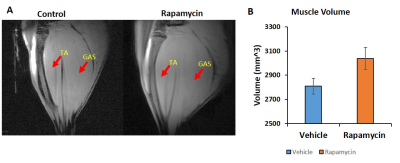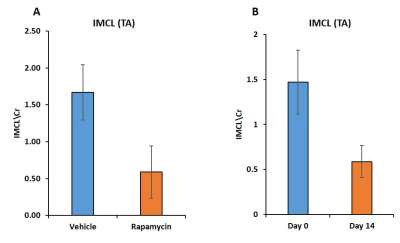Rengaraj Anantharaj1, Jadegoud Yaligar1, Giang Thi Thu Le1, Venkatesh Gopalan1, Sanjay Kumar Verma1, Kavita Kaur1, Kasthuri Thirumurugan2, Johan G Eriksson2,3, Brian Kennedy4, and S Sendhil Velan1,2
1Laboratory of Molecular Imaging, Singapore Bioimaging Consortium, A*STAR, Singapore, Singapore, 2Singapore Institute for Clinical Sciences, A*STAR, Singapore, Singapore, 3Department of Obstetrics & Gynecology, National University of Singapore, Singapore, Singapore, 4Center for Healthy Aging, National University of Singapore, Singapore, Singapore
1Laboratory of Molecular Imaging, Singapore Bioimaging Consortium, A*STAR, Singapore, Singapore, 2Singapore Institute for Clinical Sciences, A*STAR, Singapore, Singapore, 3Department of Obstetrics & Gynecology, National University of Singapore, Singapore, Singapore, 4Center for Healthy Aging, National University of Singapore, Singapore, Singapore
Rapamycin intervention increased muscle mass with reduction in IMCL,
body weight and plasma triglycerides. Imaging and biochemical
markers suggest that rapamycin can reverse muscle loss and function.


